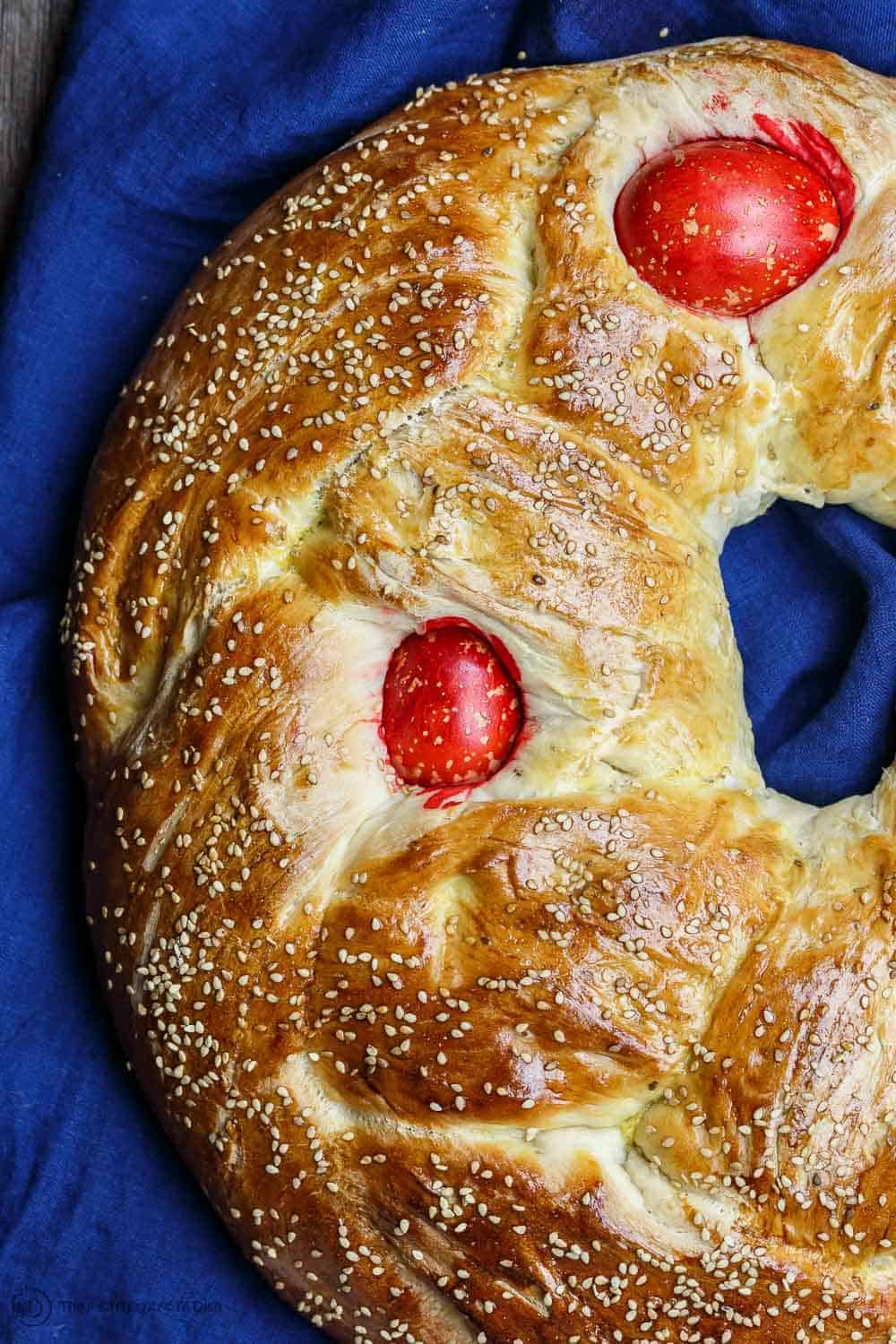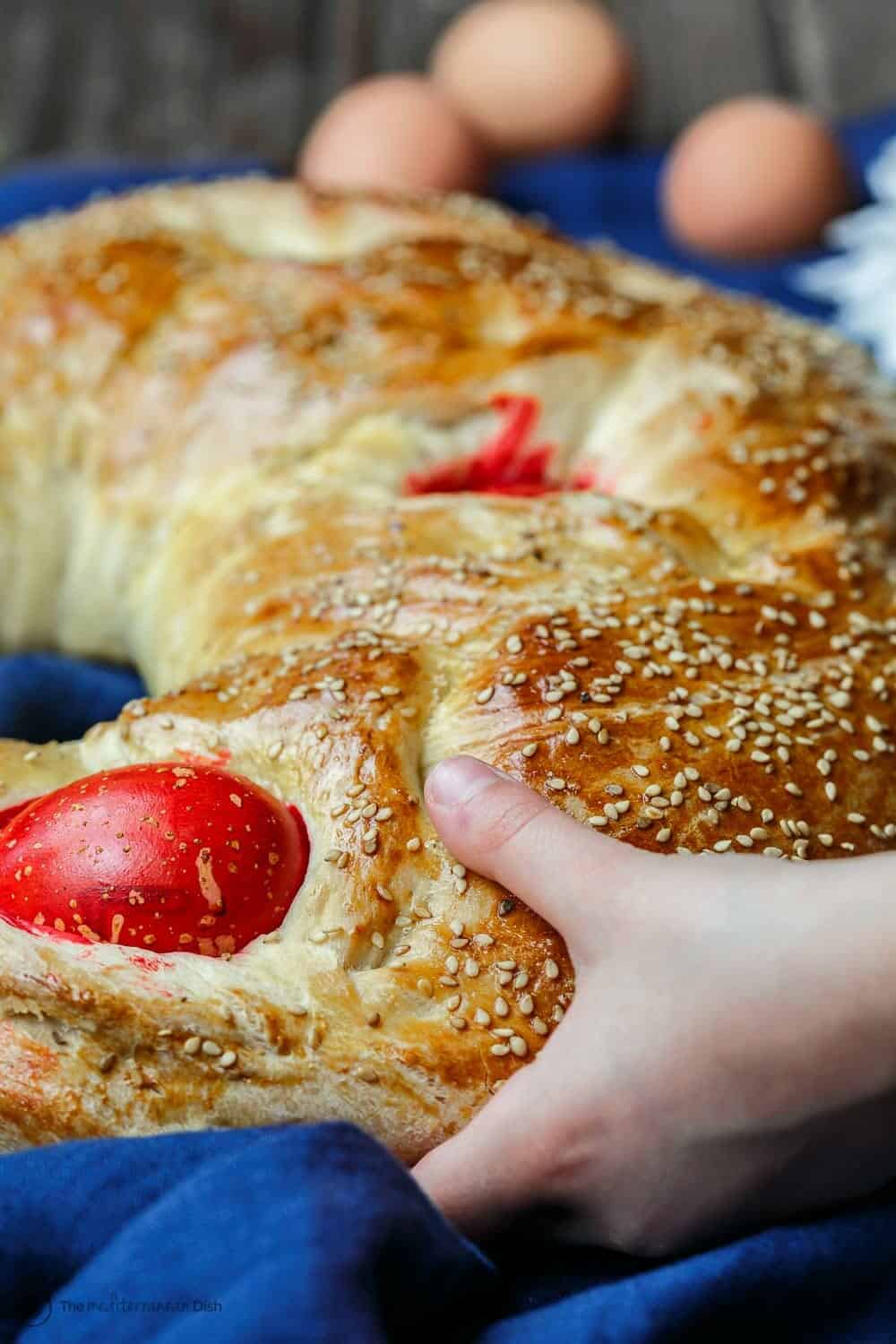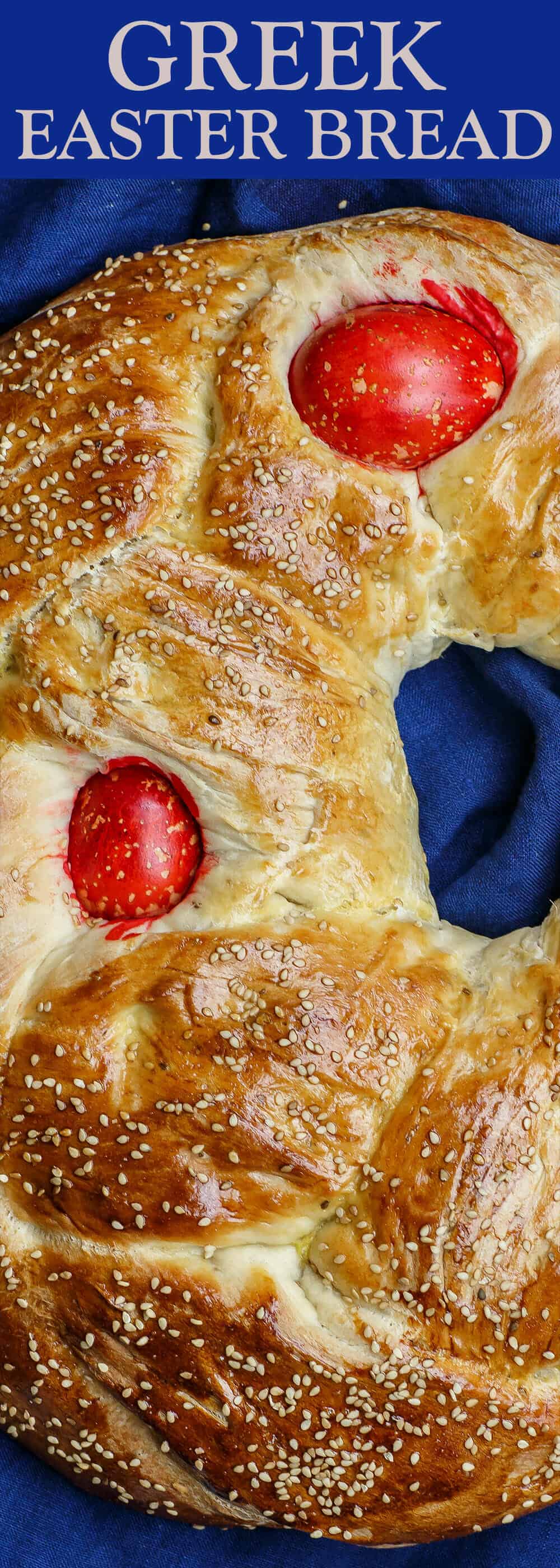Easy recipe for Tsourike: Greek Easter Bread! Sweet yeast bread that is a bit brioche-like. You’ll love this traditional dense braided loaf that’s adorned with red-dyed eggs. You can serve it as part for brunch with a little honey and feta, or as part of your dinner feast next to other favorites like this Greek lamb. Be sure to watch the video below for how to make it!
Back in the spring of 2006, I was a part of a group tour to Turkey and Greece. And very fortunately, our time there coincided with the Greek Orthodox Easter.
In Greece, as in many Mediterranean cultures, Easter preparations begin on Holy Thursday with meaningful rituals, including dying eggs in red only–symbolizing rebirth, renewal, and the blood of Christ.
These same eggs are often used as decoration for the popular Greek Easter bread known as tsoureki, which is only one of many Easter breads and baked goods we encountered on our tour. In fact, you’ll find similar breads throughout the region to celebrate the holiday, like the Italian version that’s seasoned with citrus zest rather than anise and sesame.
What is Tsoureki Bread?
Tsoureki, Greek Easter bread, is a sweeter brioche-like bread that is enriched with eggs and butter–ingredients that are forbidden during the 48-day long Lenten season.
Traditionally, Greek Easter bread recipes, depend on flavoring from ingredients like mastic and mahleb, which are mostly accessible through the internet or Middle Eastern grocers.
I surveyed several recipes to come up with an easy, more accessible Greek Easter bread recipe. And for flavoring, I borrowed a bit of an Egyptian twist by adding anise seed, which is actually not too foreign to Greek baking. Some recipes also use fennel seed.
Traditions & Greek Easter Bread
As in many parts of the Mediterranean, Greek Orthodox Christians will celebrate Easter with a special midnight mass. A festive family dinner (or super early breakfast, if you will) follows. The star is typically meat; and many will serve a popular soup called magiritsa, which is made from the organs of the lamb.
The Hinarsises, my friends who supply our Greek extra virgin olive oil, confirmed that Greek Easter bread makes it’s appearance on Easter Sunday. It’s typically served following lunch– a big feast in which copious amounts of lamb are served.
And of course, red-dyed eggs are aplenty. As family members crack their eggs against each other in a playful but meaningful manner, one greets the other, “Christos Anesti” (meaning “Christ has risen”). The response, “Alithos Anesti” (meaning “Indeed, he did!”)
How to Serve It?
Today, Tsoureki is so popular that it’s mass produced, packaged, and sold and served almost throughout the year in Greece.
You may be sitting here going, I’m not Greek! But there really is no wrong way to serve and enjoy this Greek Easter Bread recipe. For my family, we will enjoy it for a simple breakfast with more boiled eggs, and feta, or honey.
Watch the Video for How to Make Greek Easter Bread:

Easy Greek Easter Bread Recipe
- Total Time: 4 hours 45 minutes
- Yield: 1 large loaf (16 slices) 1x
Description
Tsourike: Greek Easter Bread is a sweet yeast bread that is a bit brioche-like. You’ll love this perfectly dense braided loaf that’s adorned with red-dyed eggs.
Ingredients
- 2 1/4 tsp active dry yeast (1 envelope)
- 5 1/2 cups all-purpose flour, more for dusting
- 1/2 cup sugar
- 1 1/3 cup milk
- 5 tbsp unsalted butter
- 1 tsp fine salt
- 2 large eggs, beaten, PLUS 1 egg beaten with 1 tsp water (egg wash)
- 2 tbsp anise seed
- 1/4 tsp vanilla extract
- 3 hard-boiled eggs, dyed red and fully dried
- Olive oil
- 2 to 4 tbsp toasted sesame seeds (optional)
Instructions
- In the bowl of a stand mixer, combine 1/3 cup hot water (about 110 degrees F) with the yeast, 1 tbsp of the flour, and 1 tbsp of the sugar. Whisk gently. Cover with a towel and leave aside for 10 minutes until bubbly.
- In the meantime, heat the milk in a small sauce pan until the edges begin to bubble, about 4 to 6 minutes. Remove from heat and stir in the butter, remaining sugar and salt. Set aside for 5 minutes to cool.
- Using the paddle attachment of your stand mixer, stir the milk mixture into the yeast mixture. While paddle is stirring, add the 2 beaten eggs. Gradually mix in the flour, anise seed, and vanilla extract. Beat unit a soft dough forms. Increase speed to medium (or medium-high if needed) until the dough pulls away from the sides of the bowl.
- Transfer dough onto a lightly floured surface (dough will be sticky at this point.) Kneed by hand until very smooth (about 5 minutes), then place dough into a lightly-oiled bowl. Cover and place in a warm, closed space for 1 1/2 hours, until doubled in size. (I had heated my oven to lowest temperature, then turned it off a few minutes before placing my covered dough in.)
- Punch dough down, and transfer to floured surface again. Cut dough into 3 equal parts, and gently roll each to form a long 16-inch rope. Transfer to a large baking sheet lined with parchment paper. Press ropes together at one end and braid fairly loosely. Form into a circle and press together on the other side. Stretch the circle to about 10 inches across and the hole in the middle about 3 1/2 inches wide.
- Cover with a clean towel and place back in warm space for 1 hour until doubled in size.
- Rub the dyed eggs with olive oil, and buff with paper towel. Select three spots in the dough, evenly spaced, and gently insert the eggs. Cover and return to warm space. Let rise 1 more hour until dough doubles in size.
- Heat oven to 350 degrees F. Brush the bread with the egg wash and sprinkle with toasted sesame seeds. Bake about 45 minutes until braided loaf turns a nice deep golden brown (should sound hallow when you tap on it.)
- Let cool for about 30 minutes before serving. Serve with more boiled eggs, honey or other breakfast items. Enjoy!
Notes
- Cook’s Tip 1: Make the boiled eggs and dye them first. Set aside to fully dry before use in this bread recipe.
- Are the eggs within the bread edible? We simply sliced around the eggs and did not eat them, they had been boiled then baked with the bread.
- Additional Notes: Traditional recipes rely on mastic and mahlab for flavoring. This modern recipe is tailored for the North American kitchen, relying on anise seed for flavor and topped with toasted sesame for added texture. You can use toasted slivered almonds in place of sesame seeds, if you prefer
- Recommended for this Recipe: Our Private Reserve Greek extra virgin olive oil (from organically grown and processed Koroneiki olives!)
- Visit The Mediterranean Dish store for quality Greek extra virgin olive oils and spices.
- Prep Time: 4 hours (3 1/2 hours inactive time)
- Cook Time: 45 mins
- Category: Bread
- Method: Baked
- Cuisine: Greek
Try these delicious recipes:





How much mahlab would you use in this recipe?
It’s hard to say, Kelly, as we’ve never tested this specific recipe with mahlab before.
I live in Denver, CO and have enormous difficulty making bread here. I always loved making the Easter Bread when we lived at sea level. What adjustments would I have to make to have this bread turn out? It looks so wonderful and I very much want to try it this Easter.
Thank you so much for this website!
Carol
Hi, Carol. Thank you for your question. Honestly, we’re not sure what adjustments would need to be made with this recipe since we don’t have the issue of high elevation here. Hopefully another reader here will be able to help out. I’m so sorry.
Made my first Tsoureki with this recipe for Greek Easter. It came out perfect and was approved by my 99 year old mother who has baked many loaves of Tsoureki in her lifetime! Thank you, I love all your recipes.
Yesss! Love to hear it! Thanks, Maria!
Mine came out more like the texture of Irish Soda bread which is not my fave. It did not have the “spring” like the video but basically looked the same. Might I have handles it too much or too warm rise space? I live in Florida – does elevation effect it much? To repeat, what do you suggest I change first. Also – I sifted the flour. Is that a no no?
An excellent resource for a foodie like me. I love exploring new cultures, making new recipes, trying out new cuisine.
Now more than ever while stuck at home, I am appreciating this helpful list so much more. Thanks.
So glad you found it helpful!
I have a similar recipe and use raw dyed eggs.. handle with care… they cook up just fine in the bread & very edible.
Do you think I can use an all-purpose gluten-free flour in this recipe?
Hi, Karen. I’ve never tested this recipe with gluten free flour, but if you have a brand that has worked well for you in your baking before, I would give it a try! If you do, please stop back and let us know if you have any suggestions.
No cinnamon!?!?!? That is the whole point of the flavor! Add a bunch of cinnamon and 3 times the sugar and eyeball the bread until golden brown but still soft inside. Easy recipe so that is good, ust needs those modifications.
Thank you for the feedback, Elise.
I would like to try this recipe but don’t have anise seeds. 1. Can I use mahleb? If so, 2. do I keep the vanilla extract or not? I will use slivered almonds instead of sesame seeds as I do not have seeds. 3. Do I toast the slivered almonds? Thank you for taking the time to respond
I have not tried it with mahleb, but it would work and you can leave the vanilla in. You may not need to toast the almonds since the bread is going in the oven, but you can lightly toast them if you like.
Cooking time is too long. Bread was very crusty and my family including a Greek daughter in law did not enjoy it. I was hoping it would be a taste of home for her 😢
I made your recipe except I added a little more sugar because we like it a bit more sweet. I doubled the recipe and made two huge loafs. Not only were they beautiful but it was delicious. It didn’t make it through the night between my husband, his brother and myself. It’s not exactly like my YiaYia’s because instead of Anise they use Mahleb and Matcha…I think that’s the names. I’d have to order that. But your recipe is Beautiful! The texture was perfect. I was kneading for a while and used a little olive oil I’d dip my hand into and rub little bit in with kneading. I was able to manipulate the dough much better. Also I’m pretty sure I added a whole bottle of toasted sesame seeds. We loved it! Thank you! I’d attach a picture but no option to do so.
Kathina, thank you so much for sharing! So glad to hear this recipe was a winner for your family!
Thank you so much. I made this on Friday for Easter. The texture was great!!!!! I wanted it to be authentic so I decided to Mastica, I Made a mistake and added to much Mastica and needed more sugar. So I made another one on Saturday but it was not as airy, it was a little more dense . Did I not knead it enough or to much or was it proof to much.
Thank you overall it was very good.
Thank you for sharing your tips, Dora!
Hi Suzy,
Thank you for sharing this traditional Easter bread. I tries to make it with the ingredients listed but the bread became really hard within a few hours and we covered in with aluminum. Do you know what could have been the reason?
I am not so sure what might have been the issue Rosemary. Before covering it, I typically let the bread cool. It might also help next time to bag it in a fiber bread bag?
Hi there again,
I saw in your notes that in Greece many people use mastic for this bread. I have powdered mastic that I bought in Greece last year. How can I incorporate the mastic into the bread? How much mastic would I use and when would it be added to the recipe and do I eliminate the anise completely?? Thanks!
Hi there, you could use about 1 teaspoon of mastic and it would be incorporated in step #3 when you add in the flour etc.
Do you think I could get away with a yeast substitute?
I don’t believe so.